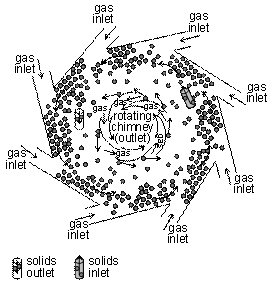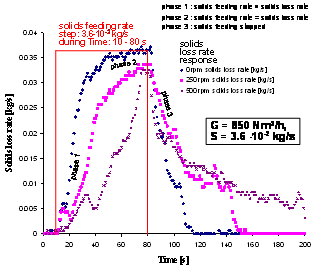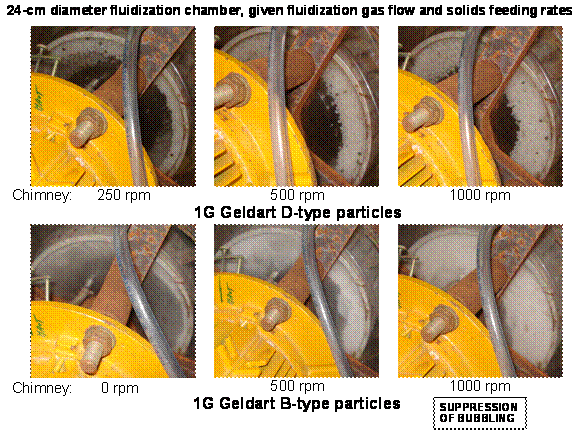87e A Rotating Chimney to Increase the Flexibility of Rotating Fluidized Beds
Abstract:
Introduction and Concept
To increase the flexibility of rotating fluidized beds, the new concept of a rotating chimney (Figure 1(a)) is introduced and experimentally investigated using 1G-Geldart D- and B-type particles. The rotating chimney consists of multiple blades separated by openings to the chimney and rotates in the same sense as the rotating particle bed. The rotational speed of the chimney and of the particle bed may, however, differ. In particular, chimney rotational speeds higher than the average particle bed rotational speed are possible. The rotating chimney then allows to increase the centrifugal force locally, i.e. in the vicinity of the chimney, making it more difficult for the particles to leave the fluidization chamber with the fluidization gas to the chimney.
Experimental set-up and Results
The action of the rotating chimney was experimentally investigated using a dual step response technique (Figure 1(b)). The responses of the rate of solids losses via the chimney and of the pressure drop over the fluidization chamber to step changes in the solids feeding rate were measured. With a well chosen step, this dynamic method allows obtaining quasi steady state data over the entire solids loading range from one single experiment. The influence of the chimney rotational speed and the fluidization gas flow rate were measured.
(a) (b) Figure 1: (a) Schematic representation of a rotating chimney in a rotating fluidized bed; (b) Dual step response technique. Steps in the solids feeding rate given (red curve) and responses in the rate of solids losses via the chimney detected. Illustration with the solids loss rate curves from a 24-cm diameter, 11.5 cm long fluidization chamber. Fluidization gas flow rate = 850 Nm3/h, 1G-Geldart D-type solids feeding rate = 3.6×10-2 kg/s, chimney rotational speeds: 0, 250, and 500 rpm. Figure 2: Quasi-steady state solids loading in a 24-cm diameter, 11.5 cm long fluidization chamber at given fluidization gas flow rate of 850 Nm3/h and solids feeding rate of 3.6×10-2 kg/s as a function of the chimney rotational speed. Top: 1G-Geldart D-type particles; Bottom: 1G-Geldart B-type particles (suppression of bubbling at higher solids loadings). At solids loadings below the theoretical maximum solids loading in the fluidization chamber, the rate of solids losses via the chimney was found to be proportional to the solids loading in the fluidization chamber and inversely proportional to the square of the chimney rotational speed. Hence, at high chimney rotational speeds, the solids loss rate is drastically reduced and becomes almost independent of the solids loading in the fluidization chamber over a broad solids loading range. As the solids loading in the fluidization chamber approaches the theoretical maximum, the rate of solids losses via the chimney drastically increases to compensate the solids feeding rate. The fluidization gas flow rate was shown to have only a minor effect on the solids losses via the chimney. Nevertheless, at solids loadings below the theoretical maximum solids loading, the rate of solids losses via the chimney was found to decrease with increasing fluidization gas flow rate, whereas at solids loadings approaching the theoretical maximum, the rate of solids losses via the chimney was found to increase with increasing fluidization gas flow rate. As illustrated in Figure 2, increasing chimney rotational speeds allow to increase the quasi steady state solids loading in the fluidization chamber at given fluidization gas flow and solids feeding rates, up to the theoretical maximum. The latter is easily reached at chimney rotational speeds higher than the average particle bed rotational speed. Alternatively, at given fluidization gas flow rate and solids loading in the fluidization chamber, the chimney rotational speed can be used to control the particle residence time in the fluidization chamber. Finally, the pressure drop over the rotating chimney was found to be relatively small, that is, at least an order of magnitude smaller than the total pressure drop over the fluidization chamber under the conditions investigated. 

